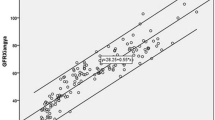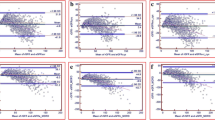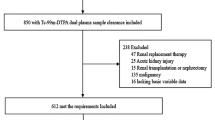Abstract
Aim
To investigate the application of the new modified Chronic Kidney Disease Epidemiology Collaboration (mCKD-EPI) equation developed by Liu for the measurement of glomerular filtration rate (GFR) in Chinese patients with chronic kidney disease (CKD) and to evaluate whether this modified form is more accurate than the original one in clinical practice.
Methods
GFR was determined simultaneously by 3 methods: (a) 99mTc-diethylene triamine pentaacetic acid (99mTc-DTPA) dual plasma sample clearance method (mGFR), which was used as the reference standard; (b) CKD-EPI equation (eGFRckdepi); (c) modified CKD-EPI equation (eGFRmodified). Concordance correlation and Passing-Bablok regression were used to compare the validity of eGFRckdepi and eGFRmodified. Bias, precision and accuracy were compared to identify which equation showed the better performance in determining GFR.
Results
A total of 170 patients were enrolled. Both eGFRckdepi and eGFRmodified correlated well with mGFR (concordance correlation coefficient 0.90 and 0.74, respectively) and the Passing-Bablok regression equation of eGFRckdepi and eGFRmodified against mGFR was mGFR = 0.37 + 1.04 eGFRckdepi and −49.25 + 1.74 eGFRmodified, respectively. In terms of bias, precision and 30 % accuracy, eGFRmodified showed a worse performance compared to eGFRckdepi, in the whole cohort.
Conclusions
The new modified CKD-EPI equation cannot replace the original CKD-EPI equation in determining GFR in Chinese patients with CKD.




Similar content being viewed by others
References
Stevens PE, O’Donoghue DJ, de Lusignan S, Van Vlymen J, Klebe B, Middleton R et al (2007) Chronic kidney disease management in the United Kingdom: NEOERICA project results. Kidney Int 72(1):92–99
Zhang Q-L, Rothenbacher D (2008) Prevalence of chronic kidney disease in population-based studies: systematic review. BMC Public Health 8:117
Coresh J, Astor BC, Greene T, Eknoyan G, Levey AS (2003) Prevalence of chronic kidney disease and decreased kidney function in the adult US population: Third National Health and Nutrition Examination Survey. Am J Kidney Dis 41(1):1–12
Excerpts from the USRDS Annual Data Report (2006) Am J Kidney Dis 49(Suppl 1):S1–S296
Kim NH, Hyun YY, Lee KB, Chang Y, Ryu S et al (2015) Environmental heavy metal exposure and chronic kidney disease in the general population. J Korean Med Sci 30(3):272–277
Lee CK, Swinford RD, Cerda RD, Portman RJ, Hwang W et al (2012) Evaluation of serum creatinine concentration-based glomerular filtration rate equations in pediatric patients with chronic kidney disease. Pharmacotherapy 32(7):642–648
Lujambio I, Sottolano M, Luzardo L, Robaina S, Krul N et al (2014) Estimation of glomerular filtration rate based on serum cystatin C versus creatinine in a uruguayan population. Int J Nephro 2014:837106
Lopez-Giacoman S, Madero M (2015) Biomarkers in chronic kidney disease, from kidney function to kidney damage. World J Nephrol. 4(1):57–73
Cockcroft DW, Gault MH (1976) Prediction of creatinine clearance from serum creatinine. Nephron 16(1):31–41
Levey AS, Bosch JP, Lewis JB, Greene T, Rogers N et al (1999) Modification of Diet in Renal Disease Study Group. A more accurate method to estimate glomerular filtration rate from serum creatinine: a new prediction equation. Ann Intern Med 130(6):461–470
Levey AS, Stevens LA, Schmid CH, Zhang YL, Castro AF 3rd et al (2009) CKD-EPI (chronic kidney disease epidemiology collaboration). A new equation to estimate glomerular filtration rate. Ann Intern Med 150(9):604–612
Larsson A, Malm J, Grubb A, Hansson LO (2004) Calculation of glomerular filtration rate expressed in mL/min from plasma cystatin C values in mg/L. Scand J Clin Lab Invest 64(1):25–30
Grubb A, Nyman U, Björk J, Lindström V, Rippe B et al (2005) Simple cystatin C-based prediction equations for GFR compared with the MDRD prediction equation for adults and the Schwartz and the Counahan-Barratt prediction equations for children. Clin Chem 51(8):1420–1431
Gates GF (1982) Glomerular filtration rate: Estimation from fractional renal accumulation of 99Tcm-DTPA (stannous) [J]. Am J Roentgenol 138(3):565–570
Xie P, Huang JM, Lin HY, Wu WJ, Pan LP (2013) CKD-EPI equation may be the most proper formula based on creatinine in determining glomerular filtration rate in Chinese patients with chronic kidney disease. Int Urol Nephrol 45(4):1057–1064
Stevens LA, Schmid CH, Greene T, Zhang YL, Beck GJ et al (2010) Comparative performance of the CKD epidemiology collaboration (CKD-EPI) and the modification of diet in renal disease (MDRD) Study equations for estimating GFR levels above 60 ml min−11.73 m−2. Am J Kidney Dis 56(3):486–495
White CA, Akbari A, Doucette S, Fergusson D, Knoll GA (2010) Estimating glomerular filtration rate in kidney transplantation: is the new chronic kidney disease epidemiology collaboration equation any better? Clin Chem 56(3):474–477
Pei XH, He J, Liu Q, Zhu B, Bao LH et al (2012) Evaluation of serum creatinine- and cystatin C-based equations for the estimation of glomerular filtration rate in a Chinese population. Scand J Urol Nephrol 46(3):223–231
Liu X, Gan X, Chen J, Lv L, Li M et al (2014) A new modified CKD-EPI equation for chinese patients with type 2 diabetes. PLoS One 9(10):e109743
Blaufox MD, Aurell M, Bubeck B, Fommei E, Piepsz A et al (1996) Report of the radionuclides in nephrourology committee on renal clearance. J Nucl Med 37(11):1883–1890
Eknoyan G, Levin N (2001) NKF-K/DOQI clinical practice guidelines: update 2000, Foreword. Am J Kidney Dis 37(1 suppl 1):S5–S6
Xie P, Huang J-M, Liu X-M, Wu W-J, Pan L-P et al (2013) 99mTc-DTPA renal dynamic imaging method may be unsuitable to be used as the reference method in investigating the validity of CKD-EPI equation for determining glomerular filtration rate. PLoS ONE 8(5):e62328
Blaufox MD, Aurell M, Bubeck B, Fommei E, Piepsz A et al (1996) Report of the radionuclides in nephrourology committee on renal clearance. J Nucl Med 37(11):1883–1890
Haycock GB, Schwartz GJ, Wisotsky DH (1978) Geometric method for measuring body surface area: a height-weight formula validated in infants, children and adults. J Pediatrics 93(1):62–66
Pöge U, Gerhardt T, Stoffel-Wagner B, Palmedo H, Klehr HU et al (2007) Can modifications of the MDRD formula improve the estimation of glomerular filtration rate in renal allograft recipients? Nephrol Dial Transplant 22(12):3610–3615
Earley A, Miskulin D, Lamb EJ, Levey AS, Uhlig K (2012) Estimating equations for glomerular filtration rate in the era of creatinine standardization: a systematic review. Ann Intern Med 156:785–795 (W–270, W–271, W–272, W–273, W–274, W–275, W–276, W–277, W–278)
Lee CK, Swinford RD, Cerda RD, Portman RJ, Hwang W et al (2012) Evaluation of serum creatinine concentration-based glomerular filtration rate equations in pediatri-c patients with chronic kidney disease. Pharmacotherapy 32(7):642–648
Rigalleau V, Lasseur C, Raffaitin C, Perlemoine C, Barthe N et al (2006) Glucose control influences glomerular filtration rate and its prediction in diabetic subjects. Diabetes Care 29:1491–1495
Kawamoto R, Kohara K, Tabara Y, Miki T, Ohtsuka N et al (2008) An association between body mass index and estimated glomerular filtration rate. Hypertens Res 31:1559–1564
Fontela PC, Winkelmann ER, Ott JN, Uggeri DP (2014) Estimated glomerular filtration rate in patients with type 2 diabetes mellitus. Rev Assoc Med Bras 60(6):531–537
Dopuda M, Ajdinović B, Jauković L, Petrović M, Janković Z (2008) Influence of the background activity region selection on the measurement of glomerular filtration rate using the Gates method. Vojnosanit Pregl 65(10):729–732
Assadi M, Eftekhari M, Hozhabrosadati M, Saghari M, Ebrahimi A et al (2008) Comparison of methods for determination of glomerular filtration rate: low and high-dose Tc-99m-DTPA renography, predicted creatinine clearance method, and plasma sample method. Int Urol Nephrol 40(4):1059–1065
Author information
Authors and Affiliations
Corresponding author
Ethics declarations
Conflict of interest
The authors have declared that no competing interests exist.
Ethical approval
All procedures performed in studies involving human participants were in accordance with the ethical standards of the institutional and/or national research committee and with the 1964 Helsinki declaration and its later amendments or comparable ethical standards.
Informed consent
Informed consent was obtained from all individual participants included in the study.
Rights and permissions
About this article
Cite this article
Xie, P., Huang, Jm., Li, Y. et al. The modified CKD-EPI equation may be not more accurate than CKD-EPI equation in determining glomerular filtration rate in Chinese patients with chronic kidney disease. J Nephrol 30, 397–402 (2017). https://doi.org/10.1007/s40620-016-0307-4
Received:
Accepted:
Published:
Issue Date:
DOI: https://doi.org/10.1007/s40620-016-0307-4




